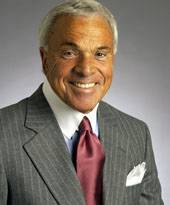This year marks the fifteenth anniversary of a major embarrassment for Time Magazine: its decision to darken O.J. Simpson’s booking photo when he was arrested for murder. The manipulated mugshot was published on the cover of Time’s June 28, 1994 issue.
The magazine came under withering criticism from the NAACP and other civil rights organizations. Time quickly issued a plaintive though conditional mea culpa. “Every major news outlet routinely crops and retouches photos to eliminate minor, extraneous elements, so long as the essential meaning of the picture is left intact,” then-Managing Editor James R. Gaines explained in the next issue of the magazine.
Those essential meanings must have been overlooked when Time published on its website earlier this week a list and photos of 25 people it believes most responsible for the current financial crisis.
The printed content was okay, giving brief but concise analysis linking its picks to our current woes.
However, Time superimposed the photos of the 25 people on horizontal “height lines” used to measure criminal suspects when their booking photos are taken. It also almost certainly pasted their faces onto the bodies of other people (I couldn't get an answer from the magazine). In its portrayal, former Texas Sen. Phil Gramm, R-TX, is wearing a suit so much nattier than his normal attire I thought a group of conservative Republicans had surreptitiously lobbied Bravo to revive “Queer Eye.”
- Former Sen. Phil Gramm, shilling for John McCain during the presidential campaign, wearing his normal nondescript attire.
- Phil Gramm in Time's rendition, apparently vying for a revival of "Queer Eye for the Straight Guy."
But if this was a photographic stab at satire, why not put the figures in jail stripes or clown attire instead of business suits, which is just a version of what they normally wear anyway? And why accompany doctored photos with such matter-of-fact copy?
Larry Pryor, a former editor at the Los Angeles Times and now a professor who teaches online journalism at the University of Southern California, was dismayed at Time’s work. “The photos all appear to have been Photoshopped. The heads and bodies don't match, giving them a curious, unnatural tension, like they (are) suspects squirming in guilt,” he said.
"This should have been published as an editorial cartoon instead," said Kent Kirkton, director of the Center for Photojournalism and Visual History at California State University, Northridge and chair of the university's journalism department. Kirkton added that many readers of the feature may not have been aware of the specific purpose of the setting, given the horizontal booking lines are only labeled for height in a group montage.
Kirkton believes Time took itself off the ethical hook by labeling the pictures photo illustrations. This follows the ethical code of the Society of Professional Journalists regarding photos. However, the code also includes such admonishments that photos "not oversimplify or highlight incidents out of context," and "never distort the content of news photos or video."
Nonetheless, Kirkton still dismissed the feature as "junk journalism."
Ed Wasserman, Knight professor of journalism at Washington and Lee University and a former columnist and editor with the Miami Herald and editorial director of Media Central, believes the intent of the feature is fairly clear as satire. “They’re being held up to ridicule,” he said.
However, Wasserman, Pryor and Kirkton all agree that the Time feature was in terrible taste. Wasserman was greatly offended by the poll that accompanied the feature: vote on whether each individual is “guilty” or “innocent” of damaging the economy.
“Although the pictorial was lame, I could live with it,” Wasserman said. “What I don’t like is this…bogus poll that they’ve attached to it, based on this distorted summary of supposed wrongdoings that are based on immensely complicated patterns of behavior. I find that sort of populist referendum objectionable; it gives (Website visitors) a false sense of public participation.” He noted that such a poll creates a feeling that participants are getting an opportunity to “lynch” the people on the list.
- Former Countrywide CEO Angelo Mozilo's standard corporate mugshot.
Pryor didn’t directly equate this feature with the darkening of O.J. Simpson’s booking photo, but he said the comparison was telling.
“If anyone of color had participated in that editorial decision, the photo would not have been used, much less darkened,” Pryor said by e-mail of the O.J. blot. “I'm not up on what Time's staff looks like these days, but from reading the online product, it would seem the lack of diversity has been more than compensated for by hiring young guns who revel in failure and humiliation ... or maybe it's just one prolific idiot. But it does give one the sense that the Web features are written by (a) cubicle of preppies raised on Mad Magazine.”
Time’s conduct went beyond a potential SPJ code violation, Pryor suggested. Only one person portrayed among the 25 -- Bernard Madoff -- is facing criminal charges. The others will certainly never face arrest or prosecution for their economy-related (mis)deeds.
(Note: You can view every article as one long page if you sign up as an Advocate Member, or higher).







